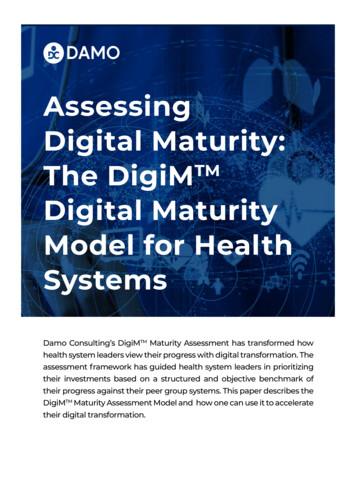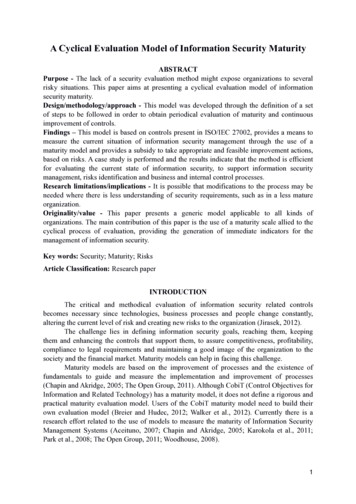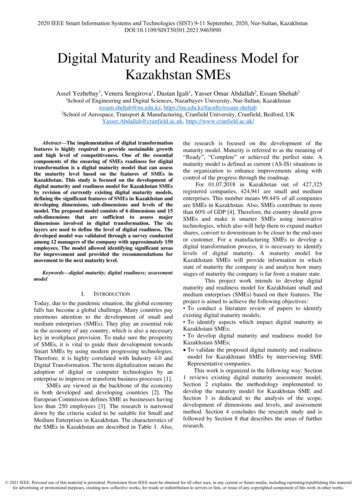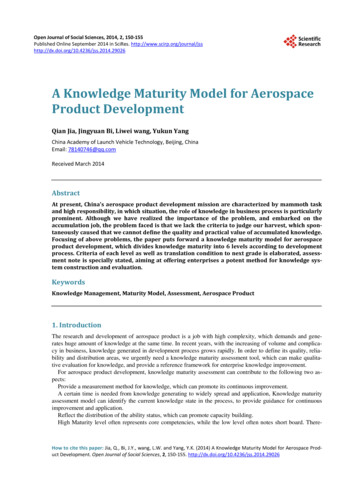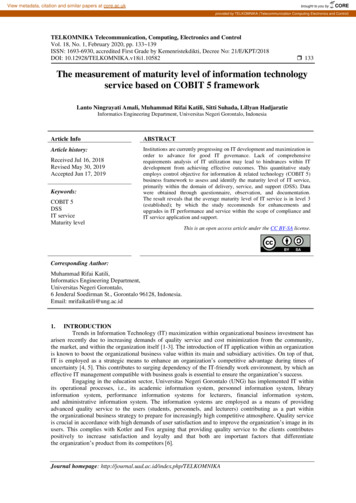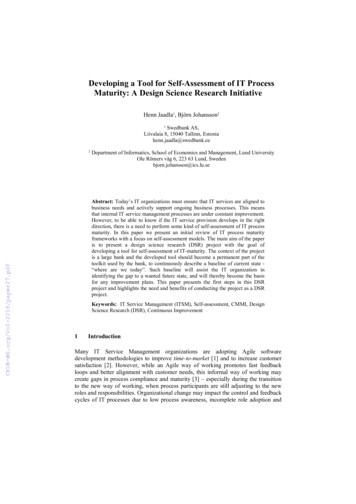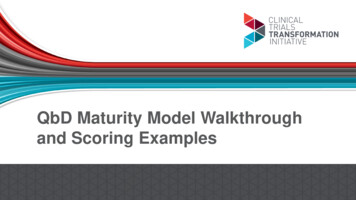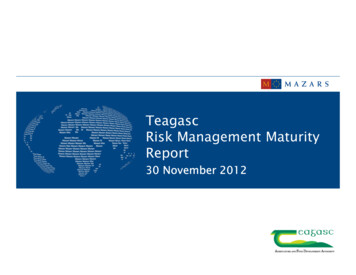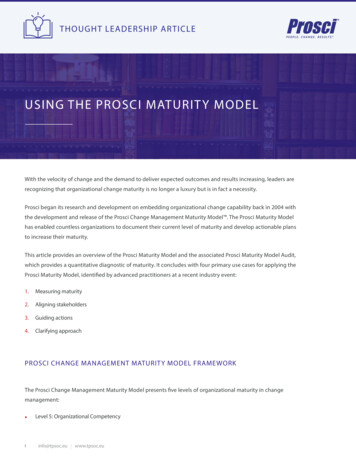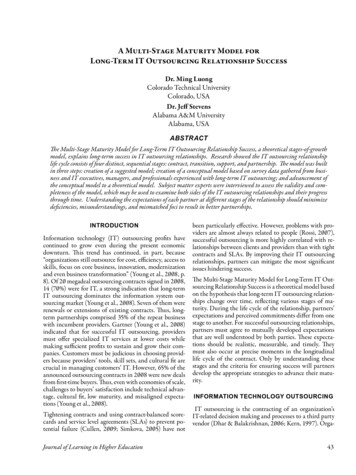
Transcription
A Multi-Stage Maturity Model forLong-Term IT Outsourcing Relationship SuccessDr. Ming LuongColorado Technical UniversityColorado, USADr. Jeff StevensAlabama A&M UniversityAlabama, USAABSTRACTThe Multi-Stage Maturity Model for Long-Term IT Outsourcing Relationship Success, a theoretical stages-of-growthmodel, explains long-term success in IT outsourcing relationships. Research showed the IT outsourcing relationshiplife cycle consists of four distinct, sequential stages: contract, transition, support, and partnership. The model was builtin three steps: creation of a suggested model; creation of a conceptual model based on survey data gathered from business and IT executives, managers, and professionals experienced with long-term IT outsourcing; and advancement ofthe conceptual model to a theoretical model. Subject matter experts were interviewed to assess the validity and completeness of the model, which may be used to examine both sides of the IT outsourcing relationships and their progressthrough time. Understanding the expectations of each partner at different stages of the relationship should minimizedeficiencies, misunderstandings, and mismatched foci to result in better partnerships.INTRODUCTIONInformation technology (IT) outsourcing profits havecontinued to grow even during the present economicdownturn. This trend has continued, in part, because“organizations still outsource for cost, efficiency, access toskills, focus on core business, innovation, modernizationand even business transformation” (Young et al., 2008, p.8). Of 20 megadeal outsourcing contracts signed in 2008,14 (70%) were for IT, a strong indication that long-termIT outsourcing dominates the information system outsourcing market (Young et al., 2008). Seven of them wererenewals or extensions of existing contracts. Thus, longterm partnerships comprised 35% of the repeat businesswith incumbent providers. Gartner (Young et al., 2008)indicated that for successful IT outsourcing, providersmust offer specialized IT services at lower costs whilemaking sufficient profits to sustain and grow their companies. Customers must be judicious in choosing providers because providers’ tools, skill sets, and cultural fit arecrucial in managing customers’ IT. However, 65% of theannounced outsourcing contracts in 2008 were new dealsfrom first-time buyers. Thus, even with economies of scale,challenges to buyers’ satisfaction include technical advantage, cultural fit, low maturity, and misaligned expectations (Young et al., 2008).Tightening contracts and using contract-balanced scorecards and service level agreements (SLAs) to prevent potential failure (Cullen, 2009; Simkova, 2005) have notJournal of Learning in Higher Educationbeen particularly effective. However, problems with providers are almost always related to people (Rossi, 2007),successful outsourcing is more highly correlated with relationships between clients and providers than with tightcontracts and SLAs. By improving their IT outsourcingrelationships, partners can mitigate the most significantissues hindering success.The Multi-Stage Maturity Model for Long-Term IT Outsourcing Relationship Success is a theoretical model basedon the hypothesis that long-term IT outsourcing relationships change over time, reflecting various stages of maturity. During the life cycle of the relationship, partners’expectations and perceived commitments differ from onestage to another. For successful outsourcing relationships,partners must agree to mutually developed expectationsthat are well understood by both parties. These expectations should be realistic, measurable, and timely. Theymust also occur at precise moments in the longitudinallife cycle of the contract. Only by understanding thesestages and the criteria for ensuring success will partnersdevelop the appropriate strategies to advance their maturity.INFORMATION TECHNOLOGY OUTSOURCINGIT outsourcing is the contracting of an organization’sIT-related decision making and processes to a third partyvendor (Dhar & Balakrishnan, 2006; Kern, 1997). Orga43
Ming Luong & Jeff Stevensnizations may outsource to cut costs, access advanced ITcapabilities, improve performance and reliability, and focus on their core business. Contracts specify services provided, monetary considerations, and length of time.Researchers studying IT outsourcing have agreed that thereasons for outsourcing are complex. Lacity, Hirschheim,and Willcocks (1994) found financial reasons (i.e., cutting costs, improving cost control, restructuring IT budgets) were the main motivation. Other reasons includedreturning to core competencies, facilitating mergers andacquisitions, and starting new companies. Loh and Venkatraman (1992) found companies sometimes outsourceto solve poorly run IT. Quinn (1999) added that companies use IT outsourcing to gap organizational divides intheir internal structures that cannot be achieved otherwise. Lacity and Hirschheim (1993) suggested outsourcing decisions may result from organizational politics, conflicts, and compromises. However, the focus of most IToutsourcing studies has been clients (Gonzalez, Gasco, &Llopis, 2006).Researchers have used a variety of economic theories toexplain the motives for outsourcing and the outsourcingrelationship (Gonzalez et al., 2006): agency theory, transaction cost economics theory, game theory, resource-basedtheory, and resource-dependence theory. In only a smallpercentage of studies did researchers use relationship as aunit of analysis, examining relationships primarily from acontract or economic perspective (Gonzalez et al., 2006).The primary theories used in those studies were transaction cost economics and agency theory in which clientsand vendors have conflicting goals. The concern and therisk were that differences in goals may result in self-serving, opportunistic behaviors on the part of vendors. Consistent with this theory was the common theme based onthe customer’s point of view that successful relationshipswere dependent on well-structured contracts and otherdetailed material created by legal advisors. Closely relatedto this theme was service quality, a method to measurequality, and a way to assess value versus cost. However,inter-organizational relationship theories were underrepresented (Gonzalez et al., 2006).Hyder, Heston, Paulk, and Hefley (2009) stated the imbalance between customer and provider perspectives inthe literature may be because those perspectives are betterpresented in practice by the people involved. Knowledgegained from the provider’s perspective is the provider’s intellectual property and not easily accessed. Studying thefinancial success or failure of a contract from the vendor’sperspective has also been difficult because most companies amortize fixed costs, gains, and losses or spread themacross multiple contracts within their customer base. Kernand Willcocks (2002) believed ignoring the relationship44A Multi-Stage Maturity Model for Long-Term IT Outsourcing Relationship Successperspective in IT outsourcing is paradoxical because itsimpact may be the difference between success, moderatesuccess, or failure. Therefore, research must be focused onthe outsourcing relationship. Success is not sustainable ifit is only one-sided. Contracts unfair to vendors eventually result in corner cutting, bad service, and disputes.Contracts unfair to customers result in resentment, distrust, and more dysfunction (Hyder et al., 2009; Loesche& Hefley, 2009).Thus, long-term success of IT outsourcing relationshipsis dependent on how well parties manage and meet eachother’s expectations. These expectations may be verbal(i.e., lawful contracts and SLAs) or nonverbal (i.e., psychologically perceived commitments). Parties must be awareof these expectations and manage them so they are realistic, timely, and measurable. Expectations not meetingthese characteristics cannot be mapped to success criteria.However, success criteria cannot be fully discovered unless these relationships are fully explored from both clientand vendor perspectives. To this end, this multi-stage theoretical model may be used to plan, manage, and governIT outsourcing relationships for success.CURRENT IT OUTSOURCINGMATURITY MODELSFour IT outsourcing maturity models currently exist.Lacity and Willcocks (2000) addressed the operationalaspects of the outsourcing contract, focusing on primaryactivities, key factors, and intended outcomes in their sixphase model. Alborz, Seddon, and Scheeper (2003) examined IT outsourcing process and performance based onefficiency and effectiveness as perceived by stakeholders.They created a three-stage, eight-phase model to explainthe IT outsourcing relationship. Cullen, Seddon, andWillcocks (2005) developed a four-phase life-cycle model,each phase composed of nine building blocks, with 54 keyactivities. Gottschalk and Solli-Sæther (2006) describedthe IT outsourcing relationship as a three-stage model.However, none of these models include both vendor andcustomer perspectives.As business, technology, and outsourcing evolve, individual expectations change. Partners must understand thesechanges and plan accordingly. Both the 10-year, 1.6-billion privatization contract between IBM and IndianaFamily and Social Services Administration that endedwhen both parties sued each other (McGarrah, 2011) andthe cancellation of National Health Service’s (UnitedKingdom) 1.75-billion contract with Fujitsu (Young etal., 2008) revealed the hostility, bitterness, and termination of relationships that may result from mismatchedSpring 2015 (Volume 11 Issue 1)vendor and customer foci. In contrast, healthy partnerships often result in contract renewal or extension.THE MULTI-STAGE MATURITY MODEL FORLONG-TERM IT OUTSOURCINGRELATIONSHIP SUCCESSOutsourcing contracts result in different types of management challenges for both providers and clients. Everchanging technology, the complexity of computer systemsand their environments, and accelerating economic andsocial environmental changes may result in lower hardware and software costs but higher maintenance costs, obsolete systems that must be replaced, and rapidly changing rules of business. All may make contract conditionsobsolete or undeliverable, which makes resource planningdifficult. Thus, long-term IT outsourcing contracts mustbe carefully planned, governed, and executed so clients’IT infrastructure does not become obsolete. Because ofthese dynamics, both providers and clients must adjusttheir expectations constantly, revisiting their strategies tobe successful.Long-term IT outsourcing should be viewed not just asa contract but also as a relationship in which “client andvendor(s) are connected or related via individual managersfor the duration of the contract period of an outsourcingventure” (Kern & Willcocks, 2001, p. 51). These relationships are complementary by nature (Kern & Willcocks,2000): Both key actors have something of value to contribute. Both invest in each other and depend on eachother. Both have open communication and are friendlytoward each other. Both build their relationship on interconnectionsthat cannot be easily broken.These relationships are also marked by high levels of information sharing, communication quality, collaborativeparticipation, trust, and commitment (Seo, Han, & Lee,2005).To manage long-term IT outsourcing relationships, bothparties must meet or exceed each other’s expectations.Dibbern, Goles, Hirschheim, and Jayatilaka (2004) stated success may be understood either as satisfaction, whichincludes a positive attitude toward the key actors involvedand the realization of objectives, or the performance ofactivities being outsourced. Grover, Cheon, and Teng(1996) showed success criteria are directly related to thedegree of satisfaction related to expected outcomes. Thus,Journal of Learning in Higher Educationlong-term IT outsourcing success criteria are a set of realistic, measurable, and timely expectations. Without thesecharacteristics, success criteria are undeliverable, whichconstitutes failure.The Multi-Stage Maturity Model for Long-Term IT Outsourcing Relationship Success is a maturity model, not acapability maturity model. It reflects the growth of a cyclein stages, with one stage built on the previous stage toachieve higher maturity levels until the cycle reaches thefinal expected outcome.CREATION OF THE MODELThe first three steps of Solli-Sæther and Gottschalk’s(2010) five-step process was used in building this theoretical IT outsourcing maturity model. The longitudinal nature of empirically testing, revising, and retestingtheoretical models necessitated narrowing the scope ofthe present research to the first three stages (Solli-Sæther& Gottschalk, 2010). Thus, research began with the creation of a suggested model, which was transformed intoa conceptual model and, finally, into a theoretical model(Figure 1-next page).The target population was IT and business executives,managers, and professionals from private and public sectors, including both for-profit and non-profit organizations. These individuals were accessed through (a) themembership of the International Association of Outsourcing Professionals and (b) current and past associatesof the researcher. Only individuals with direct experiencein negotiating, executing, and managing IT outsourcingrelationships were invited to participate. The contractprofile used in selecting the sample was a minimum size of 100 million and a minimum length of 3 years to ensureuninformed participants would not distort the data.A sample of 134 practitioners was invited via email withan embedded URL to the survey site hosted by SurveyMonkey, a Web-based survey engine. This group wasasked to complete questionnaires to identify and validatethe four stages of the model and the expectations associated with each stage. The sample included men andwomen with extensive experience in outsourcing either asclients or vendors. They worked across the globe for U.S.based companies in diverse industries, including banking,healthcare, wholesale suppliers, retailers, and governmentagencies. None of the participants had any vested interestin the research study other than a desire to contribute tothe body of knowledge. Of the 134 individuals invited, 51completed the surveys. However, many of these respondents answered questions concerning multiple stages;thus, actual units of analysis were much higher.45
Ming Luong & Jeff StevensA Multi-Stage Maturity Model for Long-Term IT Outsourcing Relationship SuccessFigure 1The stages-of-growth modeling process.Table 2Vendor ExpectationsDerived from the LiteratureTable 1Customer ExpectationsDerived from the LiteratureExpectationExpectationCE01 Customer can focus on core business.VE01Customer has adequate knowledge of business.CE02 Customer can obtain better and moretechnology (technology expansion) as businesscontinues to grow.VE02Customer has clear authority structure.VE03CE03 Customer can obtain services and technologiesnot available internally.Customer improves discipline andaccountability.VE04 Customer is effective in knowledge sharing.CE04 It is less expensive for customer to outsourcesince vendor can take advantage of economiesof scale.CE05 Partners build comprehensive and completecontract and SLAs.Based on previous research (Alborz et al., 2003; Cullenet al., 2005; Gottschalk & Solli-Sæther, 2006; Lacity &Willcocks, 2000), this research describes and explains IToutsourcing success with a maturity model consisting offour stages: contract, transition, support, and partnership.These four stages represent a sequential hierarchical progression, involving both vendor and client, from the timeof contract negotiation to the end of the life cycle.The Suggested ModelThe Conceptual ModelThe stages-of-growth-model perspective is one of the mostcommon in management literature and has been usedto explain how organizations move from initial development to ongoing viability (Drazin, Glynn, and Kazanjian(2004), Kazanjian and Drazin (1989). Gottschalk andSolli-Sæther (2006) indicated long-term IT outsourcingrelationships have predictable patterns of change overtime as the relationships evolve. If both vendor and customer are committed to succeeding, they may advancetheir relationship through the conceptualization of thesepatterns.Long-term IT outsourcing success criteria are a set ofrealistic, measurable expectations delivered in a timelyfashion. In the second step of model creation, participantscompleted a questionnaire concerning expectations in IToutsourcing relationships. The survey consisted of 47 expectations derived from six classical and popular theories(i.e., transaction cost economics, agency theory, resourcebased view, core competency theory, complementaryrelationship theory, and psychological obligation principles). The expectations were classified as either customerexpectations (Table 1) or vendor expectations (Table 2).Participants ranked each expectation for each stage of thesuggested model using the following scale: 1 no impor-46Spring 2015 (Volume 11 Issue 1)Customer pays for added technologies andservices as scope and complexity of servicesincrease.VE06 Customer pays on time.VE07Customer provides clear scope of work.CE06 Partners build on effective inter-organizationalteam.VE08Customer provides governance for contractand SLAs.CE07 Partners build on flexible work practices.VE09CE08 Partners build short term contract that can berenegotiated and reinterpreted later.Customer relies on vendor for service andtechnological directions.VE10Customer takes ownership of projects.CE09 Partners participate in knowledge sharing.VE11Partners build comprehensive and completecontract and SLAs.VE12Partners build on effective inter-organizationalteams.VE13Partners build on flexible work practices.VE14Partners build short term contract that can berenegotiated and reinterpreted later.CE14 Vendor has clear authority structure.VE15Partners participate in knowledge sharing.CE15 Vendor has clear and effective communication.VE16Partners share risks.CE16 Vendor meets or exceeds SLAs.VE17Staffing and skills increase for vendor toenable required support for customer.VE18Vendor profits from the outsourcing deal.VE19Vendor provides competitive advantages.CE19 Vendor does not overbill.VE20CE20 Vendor provides remedy for poor ITperformance.Vendor gains domain expertise or competitiveadvantages as the results of the contract.VE21CE21 Customer can limit IT operation risks andimprove business resiliency.Cost saving or financial improvement for thecustomer.VE22Customer has clear and effectivecommunication.VE23Partners share financial success.CE10 Partners share risks.A second group of participants from the target populationwas selected through judgmental sampling to serve as subject matter experts (SMEs) to validate the final theoretical model. These individuals all had firsthand knowledgein negotiating, managing, and executing IT outsourcingcontracts. Each SME participated in a one-on-one interview. Interviews ranged from 45 minutes to 2 hours inlength.VE05CE11 Staff reduction/redeployment for customersince vendor will support IT.CE12 Vendor has adequate IT knowledge.CE13 Vendor has adequate staffing.CE17 Vendor standardizes services and technologies.CE18 Vendor takes charge of the customers ITportfolio and resources.CE22 Vendor has financial strength.CE23 Partners share financial success.Journal of Learning in Higher EducationVE24 Customer has financial strength.47
Ming Luong & Jeff StevensA Multi-Stage Maturity Model for Long-Term IT Outsourcing Relationship Successtance, 2 low importance, 3 high importance, and 4 great importance.renew. Renewal terms are usually 3 to 5 years, as stated inthe master contract.Participants could also provide expectations not includedin the survey items. These comments were analyzed and,when appropriate, considered data for one of the expectations already listed on the instrument. For example, onecomment suggested the expectation of data center consolidation in the contract stage. Because data center consolidation is an IT service provided by IT vendors, the comment was considered the same as CE03, “Customer canobtain services and technologies not available internally.”If the respondent had already marked that expectation asbeing of great importance, no adjustment to the data wasnecessary. If the respondent had given it a lesser classification or no mark at all, then the data were adjusted toreflect the greater level for this expectation. Only two ofthe four additional expectations cited resulted in adjustments to the data.The master contract also contains clauses (terminationfor cause; termination for convenience) to cover endingthe relationship for any reason contract terms cannot bemet. These clauses are typically tied to financial penalties,reimbursements, and even contract exit assistance. Thus,termination is generally expensive for the initiating party.The unit of analysis was the stage of relationship betweenthe client and vendor in a long-term IT outsourcing contract. Analysis started with the examination of customerand vendor perspectives within each stage. Findings foreach perspective were combined to draw conclusions forthe unit and the overall theoretical model.Contract StageLong before the contract stage, customers decide to outsource. They spend time to fully understand the ramifications of their choice: the effects on IT staff, IT services,business processes, and company financials. Because theirdecision has enormous implications, most companies seekoutside legal and outsourcing consulting expertise in vetting vendors and negotiating contracts.Outsourcing relationships start when customers and vendors begin contract negotiations. This stage includes formal competitive bidding, requests for proposals, due diligence, pricing, proposals, and contract negotiation andrequires 3 to 9 months to complete. Lawyers; consultants;vendor company CEO, CFO, and CIO; client executives;and other senior managers negotiate the memorandum ofunderstanding and the master outsourcing service agreement or the master contract. The master contract includescontractual terms, services, costs, and resources involved.Resources include human resources, hardware equipment,software, facilities, third-party contracts, and intellectualproperty. The duration of these initial IT outsourcingcontract terms range between 3 and 10 years. Accordingto the SMEs, contracts of any shorter duration may discourage parties from investing in the relationship, technologies, equipment, and resources because of prohibitivecosts. After the initial term, customers have the option to48Besides the master contract, business and IT SMEs underthe watch of legal counsel from both sides develop detailedwork orders or statements of work for each IT service (e.g.,helpdesks, system administration, database administration, and application support). These statements definethe work activities, deliverables, and timelines vendorsmust execute in performance of specified work for clients.ExpectationsTwenty research participants completed thecustomer portion of the questionnaire; 12 completedthe vendor portion. The top five expectationsidentified for customers, in rank order, were CE03,CE04, CE02, CE13, and CE12. Customers’ topexpectations were cost reduction, technologyaccessibility, and technology improvement.Customers expect vendors to have adequate staffingand IT knowledge to provide high quality, costeffective outsourcing services. Customers expectaccess to services and technologies not availableinternally. They expect vendors to run customers’ IToperations and to improve their use of technology.They expect vendors to provide new and bettertechnologies to allow them to adapt to advancesin technology, business processes, and businessfunctions as their businesses grow and evolve.The top five expectations identified for vendors, rankedin order, were VE18, VE20, VE19, VE21, and VE06.Investments in the early stages of outsourcing contractsare extremely expensive for both parties but especiallyfor vendors because of the upfront investments required.Therefore, realizing a profit and timely payments areamong vendors’ greatest expectations. This is why vendorshave a vested interest in their customers’ success. Thus,their intention is not only expense and cost control butalso enhancement of customers’ revenue-generating abilities. The universal expectations are that vendors have theability to perform, will continue to have such abilities, andwill profit from their abilities and performance.Financial and resource investments at this stage are significant for both parties; thus, early IT outsourcing failure is a significant loss for both sides. In negotiating theSpring 2015 (Volume 11 Issue 1)contract, both parties must understand that both partiesmust make profits. Contracts must also be meaningfuland enforceable because fair, meaningful, enforceablecontracts are the foundation for the second stage, transition.CasesIn 2005, Sears terminated its relationship with ComputerSciences Corporation (CSC) less than a year after signingthe 1.6-billion contract, citing failure to deliver (Bierce& Kenerson, 2009; McDougall, 2005). CSC sued, disputing whether the termination was for cause or for convenience, arguing the reason for the termination was theSears-Kmart merger. When the court found in favor ofCSC, Sears had to pay CSC tens of millions of dollars intermination for convenience fees. In 2007, the two companies settled out of court for an unspecified amount paidby Sears (Bierce & Kenerson, 2009).Only months after Perot Systems and Triad Hospitalssigned a 1.2-billion, 10-year contract in 2006, Community Health Systems acquired Triad and cancelled the Perot Systems contract. Because Perot Systems had reportedzero revenue, citing heavy upfront data center investmentcosts, Community Health Systems had to pay Perot Systems substantial fees to terminate the contract for convenience (CBR Staff Writer, 2007).The 5-billion cancellation between IBM and JPMorganChase in 2004 occurred 18 months after outsourcing. Thecompanies issued a joint statement indicating the contractdid not work well. The customer, JPMorgan Chase, considered the vendor’s margins too high and wanted to beactive participants in managing their technology becauseof its potential as a competitive advantage within its industry. The vendor, IBM, did not find the arrangement financially attractive. Both companies agreed to stop tryingto make the contract work (Cowley, 2004; Kawamoto,2004).Although the first two cases show that failures are not always due to companies not doing their homework prior tosigning contracts, the case of IBM and JPMorgan Chasedoes reveal what may happen when one or both parties donot conduct due diligence thoroughly. All three cases areclear illustrations that early IT outsourcing failure resultsin significant losses for both parties.Transition StageIn the transition stage, customers transfer services andresources to vendors. This stage requires 6 to 18 monthsto complete. The SMEs believed it is the most importantstage of the entire contract relationship. In concept, thisJournal of Learning in Higher Educationstage does not start until the contract is signed. In practice, all stages are eclectic and pervasive. Although theparties plan for high-level transition in the contractualnegotiation, details cannot be determined. Services, people, licenses, and resources are usually transferred betweenmultiple vendors with relationships to the customer, notjust between one vendor and the customer. These interactions result in another level of complexity, including additional contract agreements for matters not addressedduring the contract stage.SLAs must be designed to provide IT services on time, foracceptable costs, and in accordance with specified quality.Typically, partners have 90 days after the signed mastercontract to establish the SLAs.ExpectationsTwenty-seven participants completed the survey for thetransition stage, 16 for the customer portion and 11 forthe vendor portion. The top five expectations for customers, in rank order, were CE13, CE12, CE05, CE11, andCE15. The top five expectations for vendors, in rank order, were VE11, VE01, VE07, VE04, and VE02.For both partners, transition is about transferring knowledge, creating organizational structure, defining roles andresponsibilities, and establishing services and SLAs tocomplete the contract agreement. Customers expect vendors to be adequately skilled and staffed to accomplish thetransition. They want their new IT to work seamlessly andtransparently and be better and more cost effective thanthe old. Vendors expect not only financial rewards for delivering quality and service but also good reputations andexpansion of their core skills. Some vendors create specialteams of their most experienced professionals to performtransitions.Customers must build organizations with in-depthknowledge of their business, provide necessary governance,and manage operation schedules. As responsibilities shift,they must create effective management structures with reduced staff. Vendors must build organizations with technical capability and learn their customers’ business and ITapplications and infrastructure.Both parties must communicate clearly. Although important in every stage of the life cycle, it is crucial during thisstage when interaction and knowledge transfer are morefrequent. Having clear authority structures for both parties is another expression of this expectation. Both partiesmust also retain transferred knowledge throughout theremainder of the contract.Unfortunately, many vendors believe transition is just another IT implementation consisting of project plans, ac-49
Ming Luong & Jeff Stevenstivity details within the plan, project meetings, and statusand financial reporting. Many customers abdicate theirIT responsibilities upon completi
The Multi-Stage Maturity Model for Long-Term IT Outsourcing Relationship Success, a theoretical stages-of-growth model, explains long-term success in IT outsourcing relationships. Research showed the IT outsourcing relationship life cycle consists of four distinct, sequential stages: contract, transition, support, and partnership.
